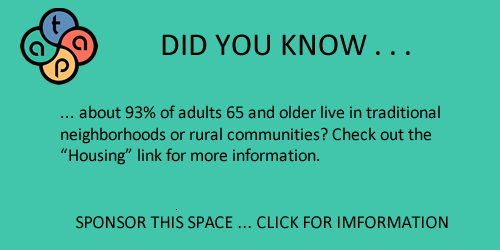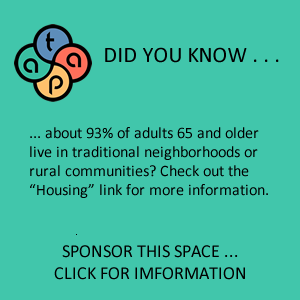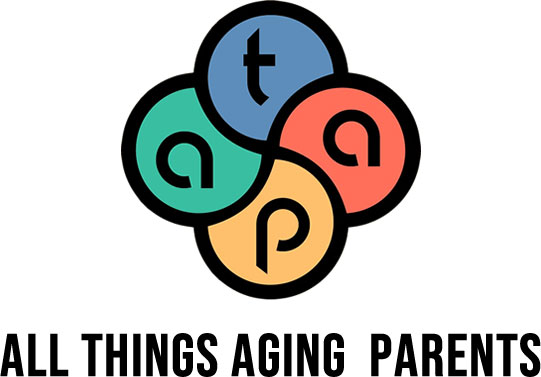Housing for your parents depends on a number of factors, including:
- Do they currently own their own home?
- How active is your parents’ lifestyle?
- What is your parents’ financial situation?
- What level of care do your parents require, or might they require in the future?
- How close do you live to your parents?
- Are you willing and able to help provide care for your parents?
The "Family Home": Many older adults have already paid off their mortgages and own their homes outright. They are comfortable and familiar with the layout and the neighbors, and the thought of moving away fills them with anxiety. But the thought of mom and dad staying in that house fills you with anxiety. You may be worried that they will fall, or have trouble with the stairs. There are several relatively simple fixes that can help to reduce your parents’ fall risk – from improving lighting in strategic areas, to removing throw rugs or electrical cords that are easy to stumble over. Occupational therapists are a great resource for identifying changes that would make the home safer. Other changes can involve more extensive renovations – like no step entryways, or a bedroom and bathroom on the ground floor. Consider consulting with a Certified Aging in Place Specialist to see what they might recommend. Obviously, these renovations are not free, you might want to think about a reverse mortgage line of credit if your parents decide to approach aging in place in their own home.
The Adult Child: Another consideration that may come with staying in the home is for one of the adult children to move in with the parents, or alternatively, for the parent(s) to move in with one of the adult children. There are too many considerations to look at here – think location, employment, suitability of your home, shared expenses, family dynamics, kind of care required, caregiving abilities, responsibility, small children, etc – but this can be simultaneously one of the most rewarding and challenging tasks of your lifetime. AARP has a great article to help you think through all of these considerations.
Accessory Dwelling Units: Also called Elder Cottage Housing Opportunities, this is just a fancy term for a “granny flat” or “mother-in-law” apartment. This may be a manufactured home built especially for aging in place, placed in your back yard, or could be a “Next Gen” suite built on to your home. This option helps to give you both a measure of privacy but keeps you nearby to help as needed. This can be particularly helpful for parents with manageable chronic illnesses, but if your parent has Alzheimer’s Disease or dementia that has progressed to the point where they are wandering, a detached dwelling may not be safe.
Active Adult Communities: These are designed for active and independent older adults, and are usually age-restricted (or at least age-targeted). This is “lifestyle housing,” organized around social and recreational activities. Services are usually not offered. Residences may be apartment complexes, individual detached homes, or any other configuration.
Co-Housing: Here you will find 20-40 residences around a common courtyard or green space with a common house with a kitchen and dining room. Services will vary by community.
These “life care communities” offer a full continuum of services from an independent living arrangement through skilled nursing care. A person might move from a rental cottage to a room in assisted living to memory care or skilled nursing care throughout the course of their lifetime. The services offered depends on which “level” the resident lives in. Usually, the resident will sign a contract that details the living arrangements and services they are guaranteed at each level, when they may be required to transfer to a higher level of care, and what costs may increase. This allows a resident to remain in the same community for the rest of their lives but does require a significant investment of money ($100,000 to $1 million) upfront in addition to monthly fees.


Long Term Care Facilities ("Service-enriched") - Housing for older adults who are less active and more reliant on help is known as “service-enriched,” or housing and care packaged together to meet the needs of the residents. The determination of how much personal (non-medical) care a person needs is usually defined in terms of Activities of Daily Living, or ADLs. ADLs include bathing, dressing, eating, toileting, caring for incontinence, and transferring in or out of a bed or chair.
These communities may be called residential care facilities, personal care homes, retirement homes, or rest homes. Each state licenses and regulates their version of this option, and each facility can differ widely in what they offer, who they admit, what they cost, etc. “Assisted” living means they have 24/7 support staff for people who don't require skilled nursing care but may have a significant need for assistance with medication management and ADLs. Meals, housekeeping, maintenance, etc are normally provided. Some assisted living facilities also serve people with dementia and Alzheimer’s Disease. One tip we recommend when you visit assisted living communities to evaluate for your parents: Does the staff look you in the eye and talk directly to you (whether or not they are the ones showing you around)? This indicates that the facility has a people-centered approach, which will reflect the care they provide for your parent. (See a list of facilities in your area)
Memory care is a specific kind of long term care designed specifically for patients with Alzheimer’s Disease or other forms of dementia. You may find these as stand-alone facilities or as units within assisted living or skilled nursing facilities. Security of the patient is a high concern in these units, so they are often secured to prevent wandering. Staff members have been specifically trained to deal with patients with dementia, providing stimulating activities and familiar structure as well as medication management and assistance with ADLs. In general, the care level is more thorough than assisted living but not as complete as in a skilled nursing facility. You will likely find a lower staff to patient ratio. It is the quality of interaction between patient and caregiver that sets a memory care unit apart from other options. This may be the most critical criteria you examine when looking for a home for your parent. (See a list of facilities in your area)
These may also be known as adult foster care homes, group homes, or residential care homes. Most states require that these be licensed above a certain number of residents. They are typically located in residential communities and are simply homes that have been adapted to accommodate a small number of older adults, and are often run by the homeowner and an aide. They usually provide meals, assistance with medication management and ADLs, but not skilled nursing care. Board and care homes may be less expensive than traditional assisted living, but have fewer options for both privacy and social activities.
Also called nursing homes, these are long-term care facilities that provide private or semi-private rooms, meals, personal care, nursing care, and medical services. Many nursing homes are also rehabilitation facilities offering therapy (physical, occupational, or speech) or recovery following hospitalization. Most residents have chronic health issues that require skilled nursing care, and/or need assistance with multiple ADLs. Some residents have Alzheimer’s disease or dementia so some facilities will have a secure unit and specialized activities to engage them. Nursing homes are often covered by Medicare for short term rehabilitation (up to 100 days). When Medicaid is available for a low-income senior’s long-term needs, it is most often available for nursing home care or home and community-based services. (See a list of facilities in your area)
Medicare has an excellent tool for comparing nursing homes. Unfortunately, this does not cover assisted living or other facilities, only nursing homes. One tip we recommend when you visit nursing homes to evaluate for your parents: Does the staff look you in the eye and talk directly to you (whether or not they are the ones showing you around)? This indicates that the facility has a people-centered approach, which will reflect the care they provide for your parent.
These apartments are designed for low income older adults who pay a percentage of their income (often about 30%) for rent. These are administrated under HUD (Housing and Urban Development) and are now being coordinated with health and social services for the residents to access.
Resources:
Certified Aging in Place Specialists:
Housing Plus Services:
Memory Care:
Board and Care Homes:
- https://www.agingcare.com/articles/guide-to-board-and-care-facilities-and-adult-foster-homes-104568.htm
- https://www.theseniorlist.com/adult-care-homes/
Nursing Homes:
- https://www.nia.nih.gov/health/choosing-nursing-home
- https://www.medicare.gov/NursingHomeCompare/checklist.pdf
Continuing Care Retirement Communities:



















